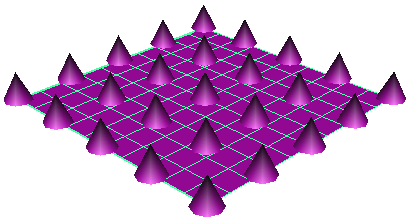Lets you use the Paint Scripts Tool to paint MEL scripts.
For more information about painting scripts, see Overview of MEL script painting and Script paint.
For more information about Artisan brush tools, see How Artisan brush tools work.
Use this to specify the settings for the Paint Scripts Tool in the Tool Settings editor.
For information about the settings in the other sections, including the Setup section, see Artisan Tool Settings.
These are the settings in the Paint Attributes section of the Tool Settings editor for the Paint Scripts Tool.
Notice that the brush stamp changes to indicate which operation is selected.

To remove the letters and gradient marking from the brush stamp, open the Tool Settings editor, click the Display tab and turn Draw Brush Feedback off.
For the geometryPaint and spherePaint scripts, replaces the values you paint over with the specified Value and Opacity.
For the emitterPaint script, replaces the values for the selected attribute of the painted emitter with Value and Opacity settings and replaces the painted emitters with emitters that have these new attributes. For example, if the selected operation is to Modify the Speed emitter attribute, the emitter speed is replaced by the Value and Opacity settings.
For the geometryPaint and spherePaint scripts, adds the specified Value and Opacity to the current values you paint over. If the Paint Offset is negative, the value actually decreases.
For the emitterPaint script, adds to the values for the selected attribute of the painted emitters by the Value and Opacity factors.
Set the value to apply when you perform any of the script painting operations. The value has a different meaning depending on the script.
For the geometryPaint and spherePaint scripts, Value refers to the size of the geometry when the Control is set to Scale. The original geometry size has a value of 1.
For the emitterPaint script, Value refers to the percentage of the selected script operation.
Set the minimum and maximum possible paint values. By default, you can paint values between 0 and 1. Setting the Min/Max Values you can extend or narrow the range of values. Negative values are useful for subtracting weight. For example, if you set Min Value to -1, Value to -0.5, and select Add for the operation, you would subtract 0.5 from the weight of vertices you paint. Positive values are used as multipliers.
Select whether you want to clamp the values within a specified range, regardless of the Value set when you paint. You can set clamping to Lower, Upper, or both.
For example, if you clamp Lower and set the lower Clamp values to 0.5, the values you paint will never be less than 0.5, even if you set Value to 0.25. Similarly, if you clamp Upper and set the upper Clamp values to 0.75, the values you paint will never be greater than 0.75, even if you set Value to 1.
geometryPaint sample script settings
You can use this script to select predefined objects in your scene and then paint them on a selected surface.
For more information about painting scripts, see Overview of MEL script painting and Script paint.
Type a name to identify the layer the painted objects belong to. By painting on different layers, you can modify the objects on one layer without affecting the objects on a different layer. For example, if you type Layer1 in this box and paint cones, then type Layer2 in the box and paint spheres, when you go back to Layer1 and paint, the spheres in Layer2 will be unaffected.
If you cannot remember a layer name, or identifier, open the Outliner and select an object belonging to the layer. The identifier name is part of the object name.
Turn Grid on to use the grid you set in the U Grid Size and V Grid Size boxes to place the geometry. If you do not turn Grid on, Maya uses the vertex position to place geometry.
For each surface you paint, do not change the grid size. Changing the grid size while you paint produces undesirable results.
Also, keep in mind that your grid settings are interpreted in part by the UV mapping technique used on the surface. Make sure the UVs are correctly projected on the surface.
Turn Jitter Grid on to randomize the position of the painted objects on the grid.
Select the desired U and V Grid Size. Artisan paints the geometry on the grid point of the U and V grid you specify here, regardless of the isoparm density you set for the surface. The larger the grid size, the denser the geometry.
In the following example, the isoparm density of the surface is 10, but the U and V Grid Size are both set to 5 in the Geometry Paint Settings window.

These controls define how painted objects are transformed. Do not select both scaleand rotation controls at the same time.
emitterPaint sample script settings
Set the spread angle for the emitted particles, along the specified emission direction. Particles are randomly distributed within the spread angle and around the base of a cone between 0 and 360 degrees. This option is valid for directional emitters only.
You can enter a value between 0 and 1. A value of 1 means 180 degrees.